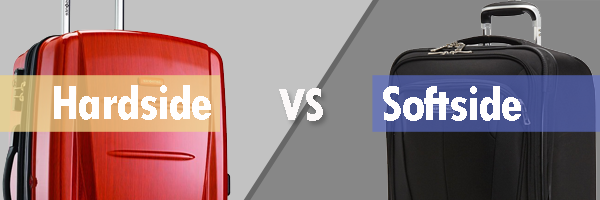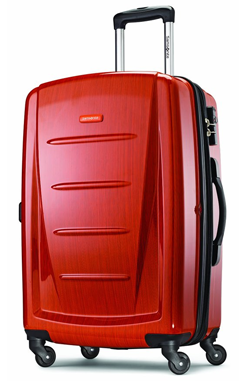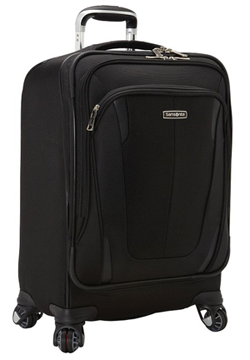
Life is full of important decisions. Mac or PC ? Dogs or cats? Ski or snowboard? Travelers across the world have their own hotly contested debate : hardside luggage or softside luggage. We’ve put together some pros and cons so you can decide which of these options will be best for your travel style.
 Hardside Luggage Pros
Hardside Luggage Pros
In recent years, advances in materials technology have made hardsided luggage increasingly popular. It is lighter and more durable than ever before. Hardside luggage enthusiasts will never travel with anything else, while skeptics still find some downsides. Here is a list of pros of hardside luggage:
- Waterproof (depending on the bag)
- Sturdy – can protect fragile items
- Easy to stack
- Easy to clean
- Shock absorbent material stands up to rough airport handling
> Check out our Top 5 Hardside Carry on Luggage article!
A hardside suitcase can also help the traveler who has problems staying under the airline weight requirement – the hard sides don’t stretch to allow you to overstuff the bag. Be careful, this inflexibility can work against you as well. These bags will not squish to fit in an already stuffed overhead bin. Be prepared to gate check a hardside carry-on.
Remember, all hardside bags are not made of the same materials. This is definitely an example of “you get what you pay for.” The best material on the market now is polycarbonate. It is lightweight and withstands abuse without cracking or denting. Pure polycarbonate hardside luggage is very expensive while cheaper hardside bags are made by just coating another material with a layer of polycarbonate.
These less expensive bags can be more rigid and therefore more susceptible to cracking or puncturing when tossed around by the baggage handlers. Do your research and rely on a trusted luggage brand if you decide to opt for hardside luggage.
Softside Luggage Pros
Though the hardside bag is having a vogue now, frequent travelers will notice many softsided bags still in use. They do boast some significant advantages over the hardside suitcase for many travelers. Here is a list of pros of softside luggage:
- Expandable
- Collapses for easy storage
- Often has exterior pockets
- Less visible wear and tear
- Easier fit in overhead compartments
Softside luggage is definitely preferred for carry-on luggage. Softside bags often have some pockets on the outside of the bag that ensure your travel items are easy to access as you pass through airports. The molded exterior of a hardside bag does not allow for this extra space. Softside bags are also easier to fit into the overhead bins. The fabric is flexible and can often fit into a space a hardside bag would not.
The tough, synthetic fabrics used for softside bags are resistant to tearing, though they do show dirt and stains quickly. The technologically advanced, tear-resistant nylon fabric used in high quality bags is incredibly lightweight, though color options are often limited.
Much of the less expensive, more colorful luggage is made from polyester. The polyester is not as durable as nylon so it is much more easily damaged. For any softside bag, ensure plastic frames or handles are secured with screws. Zippers should be water resistant with taped and reinforced seams. Be sure to consider all aspects of the bag before you purchase.
Considering TSA Regulations
When considering any luggage, it is good to be familiar with the latest TSA luggage size regulations as well as airline size and weight restrictions. Many hardside bags have locks built in, while you must purchase a lock to thread through the zipper of a softside bag.
Always keep in mind, any lock on any luggage must be TSA compliant – the TSA must be able to unlock your luggage. Their website specifically mentions locks by Safe Skies and Travel Sentry as compliant choices.
Most domestic airlines limit checked luggage to 50 pounds and 62 square inches, though they will accept oversize or overweight luggage with an extra fee, about $75. Some airlines allow business and first class passengers up to 70 pounds before a fee is charged. Carry-on bags are limited to a small size of 22” x 14” x 9” on most airlines.
Southwest gives travelers a few extra inches; their restriction is 24” x 16” x 10”. Carry-ons are rarely subject to any weight restriction. Just remember you may have to lift it over your head! It is a good idea to double check your preferred airline’s guidelines before purchasing a new piece of luggage – whether it is hardside or softside.
Conclusion
The battle of hardside vs. softside luggage will forever wage on. There is a dizzying variety of luggage online and even the most seasoned traveler can be stumped when it comes to choice. Thousands of travel bloggers tout their favorites and millions of online reviewers make their often conflicting opinions heard.
If you’ve gone crazy reading reviews and opinions, nothing beats the traditional in store experience. Find a luggage specialty store near you and get a feel (literally) for what you want, if you’re not sure which brand to go with be sure to check out the best luggage brands.

